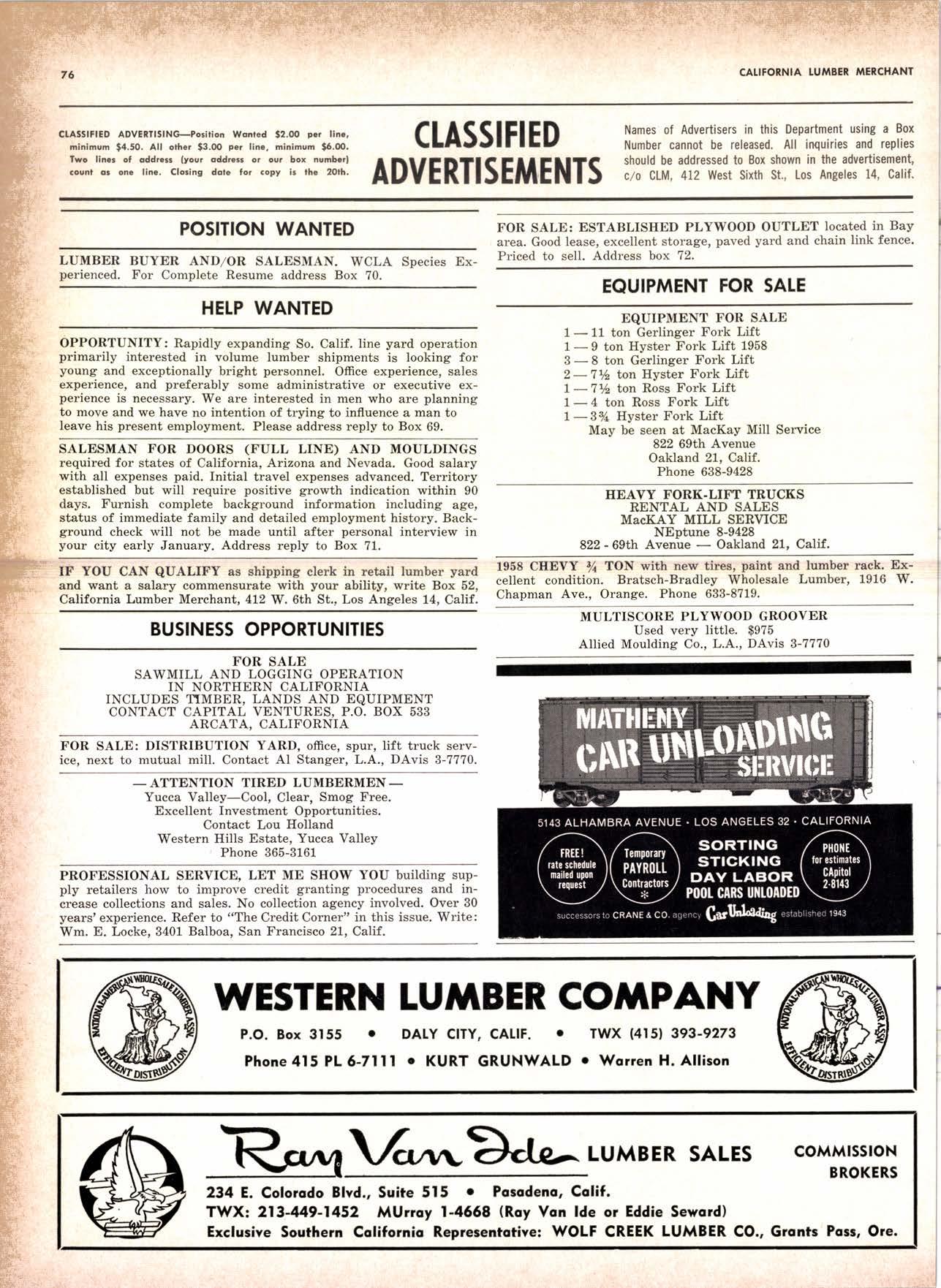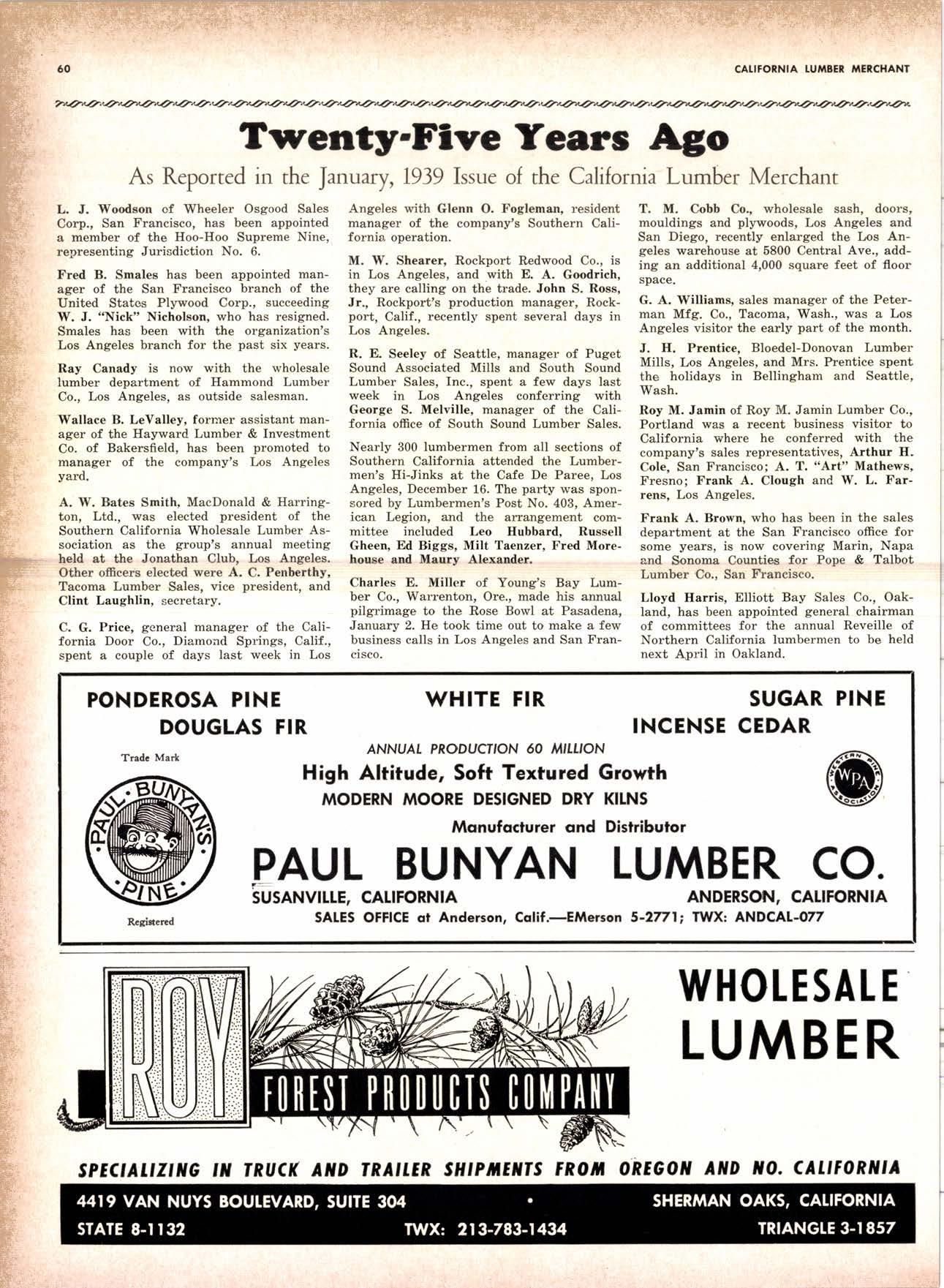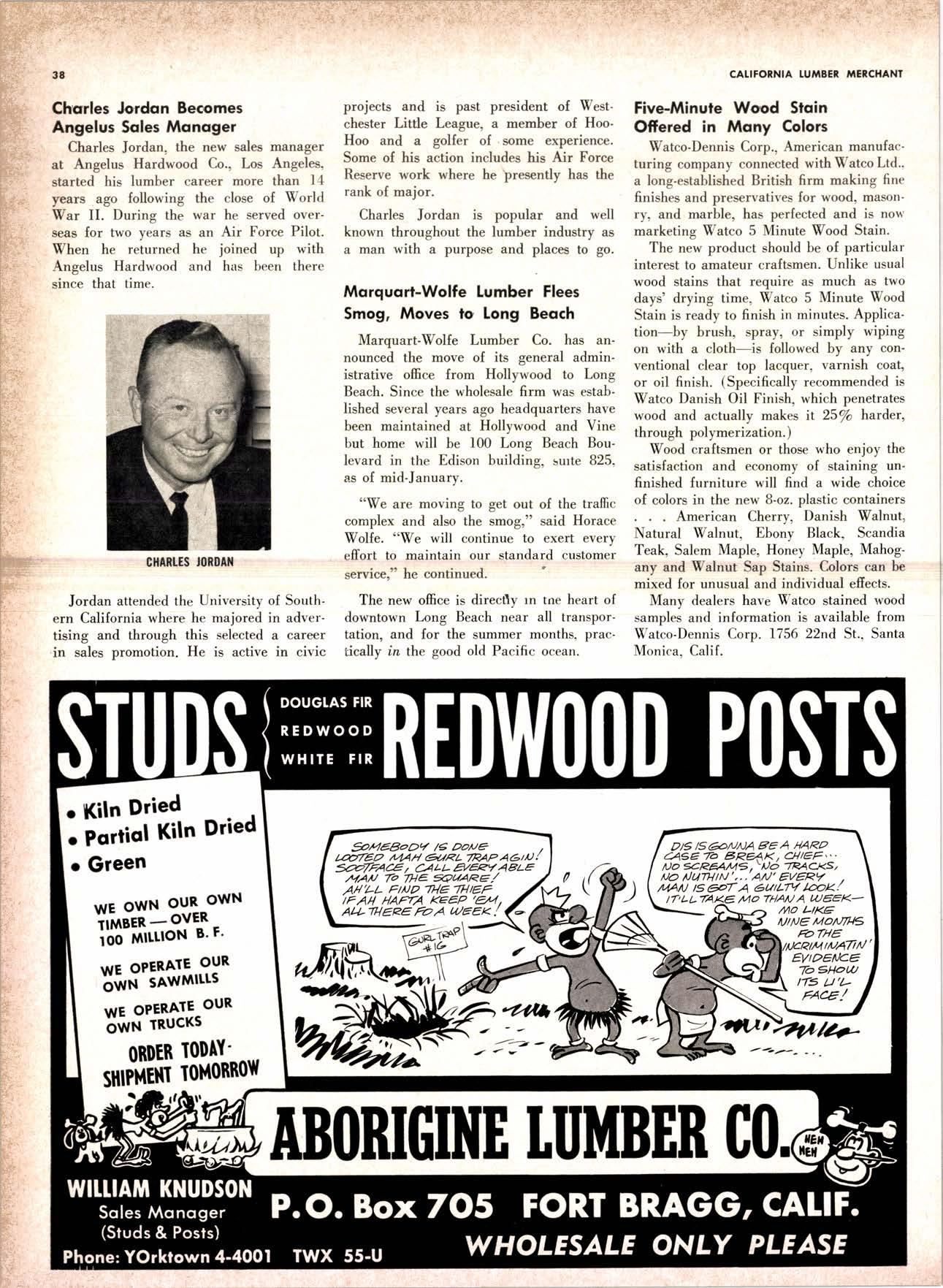
13 minute read
Vote the II{DEPEI\DENT ticket!
Here's the way to mark your ballot for building materials:
INDEPENDENI (Col Ponel pledges you complete freedom of choice)
CONTROTTED BRAND (Monufocturer owned. Choose his products, or else.)
FRANCHISE DISTRIBUTOR (Committed to push certoin bronds, regord'less)
[-e respect your indepentlenr:e in specifying lour choice of materials for any oI your jobs, just as rve insist on our own. Here. you can write your own ti<rket.
Time-saring seraice on:
The best in toltwood and, hard,wood Plyuoodr . . , Forrnica . Monkeypod Plywoods . , . Masonie Brand. Hardboard.
Bevel' ftannel - Rusfic - Board f, Batfs
Dec[ing - Paneling - Foundalion - fencing
Oreen I Dry Dimen$on tlt$tRil RHl, tilft]fit I AtA$$ yH.t(}w
Chorles Jordon Becomes Angelus Soles Monoger
Charles Jordan. the new sales manager at Angelus Hardwood Co., Los Angeles. started his lumber career more than l'1 years ago following the close of World War II. During the war he served over' seas for two years as an Air Force Pilot. When he returned he joined up with Angelus Hardwood and has been there since that time.
projects and is past president of Westchester Little League, a member of HooHoo and a golfer of some experience, Some of his action includes his Air Force Reserve work where he presently has the rank of major.
Charles Jordan is popular and well known throughout the lumber industry as a man with a purpose and places to go.
Morquort-Wolfe lumber Flees Smog, Moves to long Beqch
Marquart-Wolfe Lumber Co. has announced the move of its general administrative office from Hollywood to Long Beach. Since the wholesale firm was established several years ago headquarters have been maintained at Hollywood and Vine but home will be 100 Long Beach Boulevard in the Edison building, surte 825. a,s of mid-January.
"We are moving to get out of the traffic complex and also the smog," said Horace Wolfe. "We will continue to exert every effort to maintain our standard customer service," he continued
Five-Minute Wood Stoin Ofrered in Mony Colors
Watco-Dennis Corp,, American manufacturing company connected with Watco Ltd., a long-established British firm making fine finishes and preservatives for wood, mason' ry, and marble, has perfected and is nolr' marketing Vatco 5 Minute Wood Stain.
The new product should be of particular interest to amateur craftsmen. Unlike usual wood stains that require as much as two days' drying time, Watco 5 Minute Wood Stain is ready to finish in minutes. Application-by brush, spray, or simply wiping on with a cloth-is followed by any conventional clear top lacquer, varnish coat, or oil finish. (Specifically recommended is Watco Danish Oil Finish, which penetrates wood and actually makes it 25/o harder, through polymerization.)
Wood cra{tsmen or those who enjoy the satisfaction and economy of staining unfinished furniture will find a wide choice of colors in the new B-oz. plastic containers American Cherry, Danish Walnut, Natural Walnut, Ebony Black, Scandia Teak, Salem Maple, Honey Maple, Mahogany and Walnut Sap Stains. Colors can be mixed for unusual and individual efiects.
Jordan attended the University of Southern California where he majored in advertising and through this selected a career in sales promotion. He is active in civic
The new office is directly rn tne heart of downtown Long Beach near all transportation, and for the summer months, practically ln the good old Pacific ocean.
Many dealers have Watco stained wood samples and information is available from Watco-Dennis Corp. 1756 22nd St.. Santa Moniea. Calif.
PAUL SAYS: "O,,. policy in l964-as always-is ro conrinue to serve the dealer only. Nlason Supplies will never be the dealer's competitor. Our experienced staff is at your service now and throughout the years to come." Paul Sink has been general manager of Mason Supplies for the past 20 years.
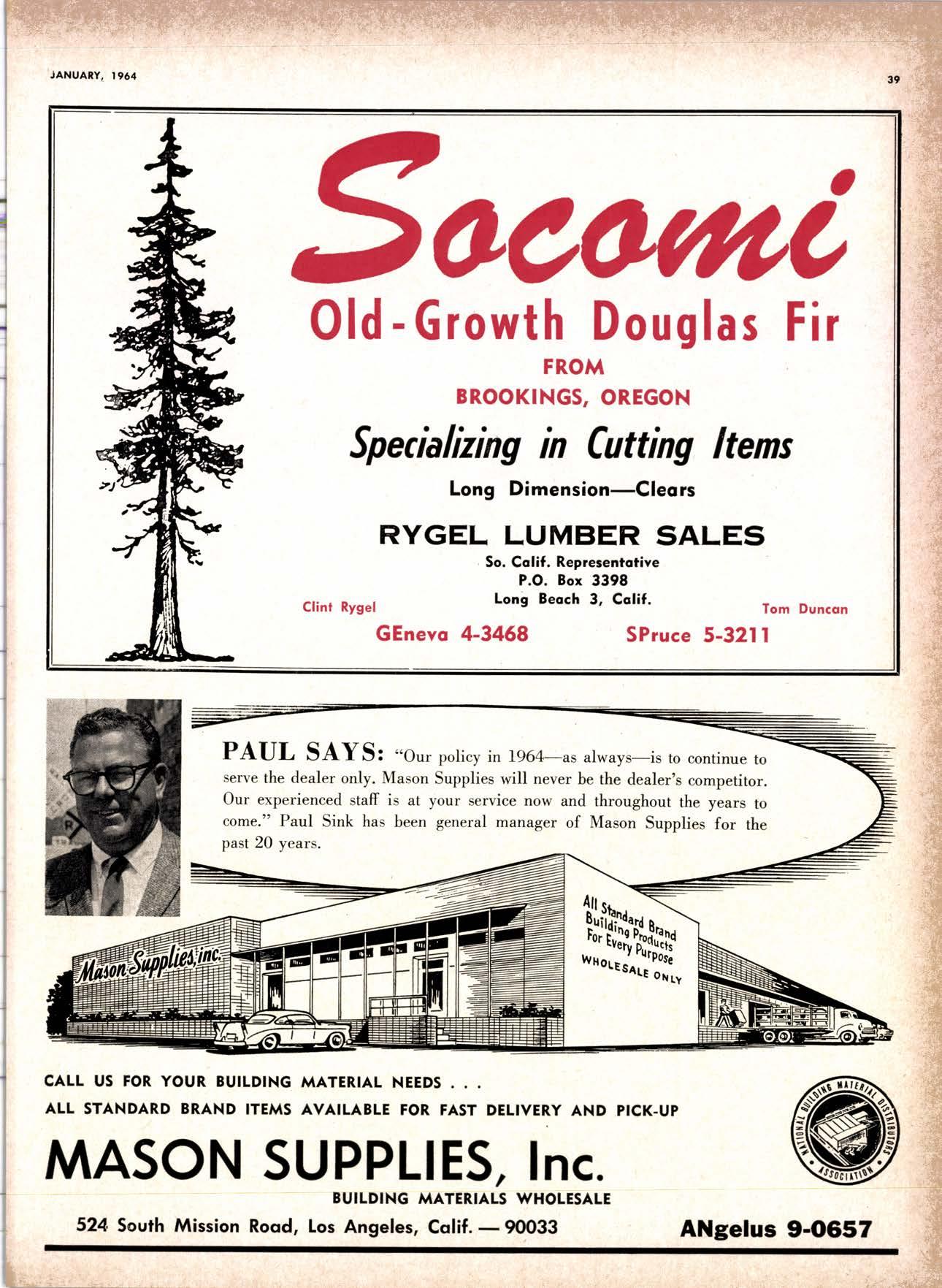
ID the foreats of coastal British Columbia, the giant Red Cedar often survives centuries of time, wind and weather. Little wonder, then, that lumber cut from this naturally timeless wood will beautify and protect homes in the most severe climates for decades more.
ITS BEAT'TY IS AGED -IN-TI{E -WOOD:
Sierro-Coscqde Conference To View Logging Problems
Iogging problems will be viewed with a new and unusual slant at the 15th annual Sierra-Cascade Logging Conferencg February 13-15, 1964, in Sacramento.
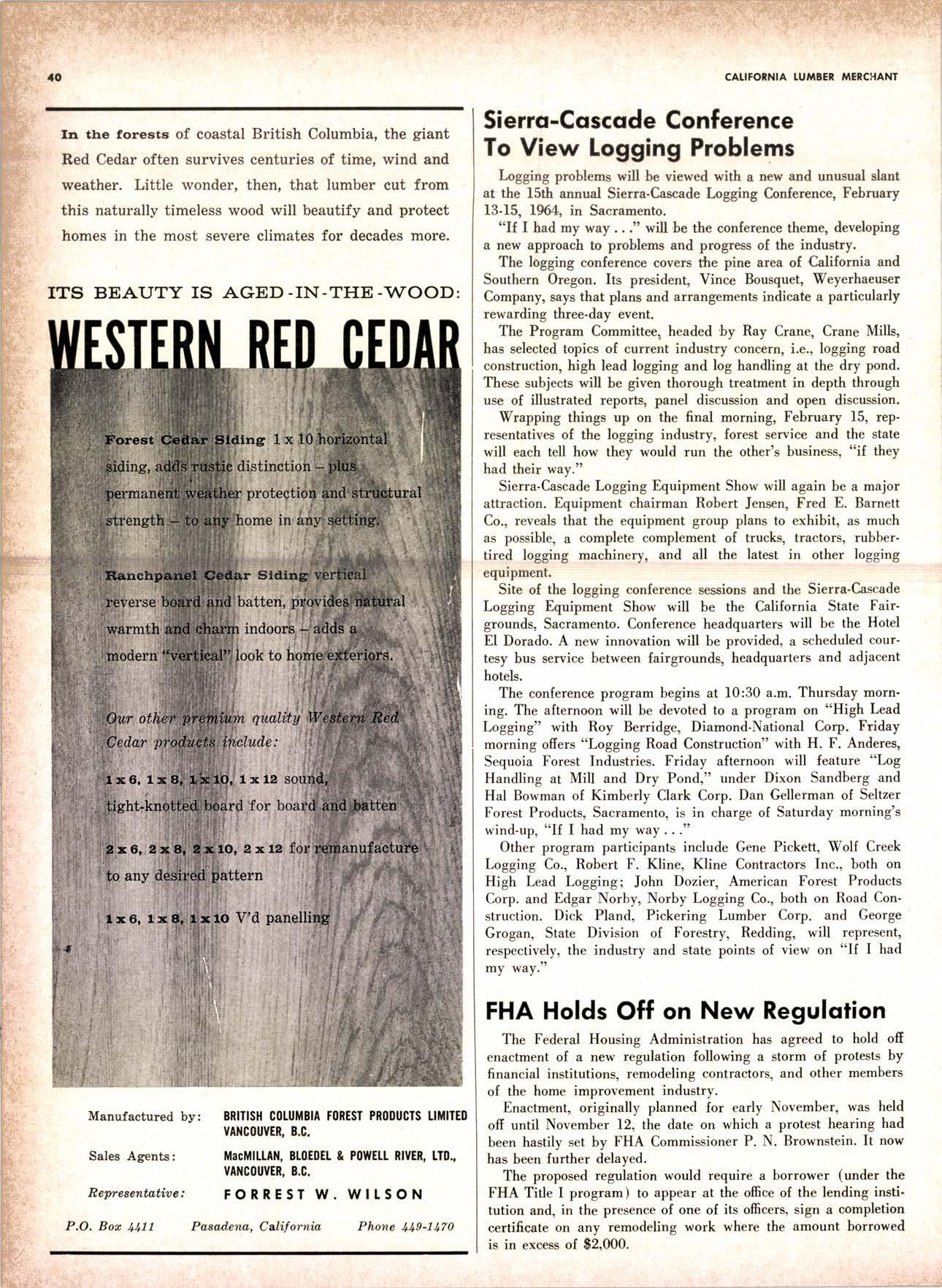
"If I had my way. ." will be the conference theme, developing a new approach to problems and progress of the industry.
The logging conference covers the pine area of California and Southern Oregon. Its president, Vince Bousquet, Weyerhaeuser Company, says that plans and arrangements indicate a particularly rewarding three-day event.
The Program Committee, headed by Ray Crane, Crane Mills, has selected topics of current industry concern, i.e., logging road construction, high lead loggrng and log handling at the dry pond. These subjects will be grven thorough treatment in depth through use of illustrated reports, panel discussion and open discussion.
Wrapping things up on the final morning, February 15, representatives of the Iogging industry, forest service and the state will each tell how they would run the other's business, "if they had their way."
Sierra-Cascade Logging Equipment Show will again be a major attraction. Equipment chairman Robert Jensen, Fred E. Barnett Co., reveals that the equipment group plans to exhibit, as much as possible, a complete complement of trucks, tractors, rubbertired logging machinery, and all the latest in other logging eguipment.
Site of the logging conference sessions and the Sierra-Cascade Logging Equipment Show will be the California State Fair' grounds, Sacramento. Conference headquarters will be the Hotel El Dorado. A new innovation will be provided, a scheduled courtesy bus service between fairgrounds, headquarters and adjacent hotels.
The conference program begins at 10:30 a.m. Thursday morn' ing. The afternoon will be devoted to a program on "High Lead Logging" with Roy Berridge, Diamond-National Corp. Friday morning ofiers o'Logging Road Construction" with H. F. Anderes, Sequoia Forest Industries. Friday afternoon will feature "Log Handling at Mill and Dry Pond," under Dixon Sandberg and Hal Bowman of Kimberly Clark Corp. Dan Gellerman of Seltzer Forest Products, Sacramento, is in charge of Saturday morning's wind-up, "If I had my way. ."
Other program participants include Gene Pickett, Wolf Creek togging Co., Robert F. Kline, Kline Contractors Inc., both on High Lead Logging; John Dozier, American Forest Prqducts Corp. and Edgar Norby, Norby Logging Co., both on Road Construction. Dick Pland, Pickering Lumber Corp. and George Grogan, State Division of Forestry, Redding, will represent, respectively, the industry and state points of view on "IfI had my way."
FHA Holds Off on New Regulotion
The Federal Housing Administration has agreed to hold ofi enactment of a new regulation following a storm of protests by financial institutions, remodeling contractors, and other members of the home improvement industry.
Manufactured by:
Sales Agents:
Reyresentnthse:
P.O. Boa 4411
BRIIISH C|ITUMBIA FOREST PRODUCTS IIiIIIEII YA}ICIIUVER, B.C.
MacMl[LAN, BL0EDEI & P0Wttt RUEI, 110., YAI{GOUVER, B.C.
FORREST W. WITSON
Pasad,ena,Calilornia Phone 4.49-1470
Enactment, originally planned for early November, was held ofi until November 12, the date on which a protest hearing had been hastily set by FHA Commissioner P. N. Brownstein. It now has been further delayed.
The proposed regulation would require a borrower (under the FHA Title I program) to appear at the office of the lending insti. tution and, in the presence of one of its officers, sign a completion certificate on any remodeling work where the amount borrowed is in excess of $2,000.
Whoiesaie Hardwoodsince I93i
TW&J Advonces Quoltrocchi To Monogement Position
Frank Quattrocchi has been named new assistant manager of Tarter. Webster & Johnson's Los Angeles distribution yard. The announ(:ement was made bv Bolr Wells. regional general manager uni dir""- partment in 1955 and also worked in the yard. Progress was steady and in 1957 he was promoted to manager of the fir department after a complete education in customer relations and sales. Only 35 years of age Frank is a young lumberman on the move. He is active in civic, fraternal and social affairs in the community and a member of the steerine committee o{ Los Angeles Hoo-Hoo club 2.
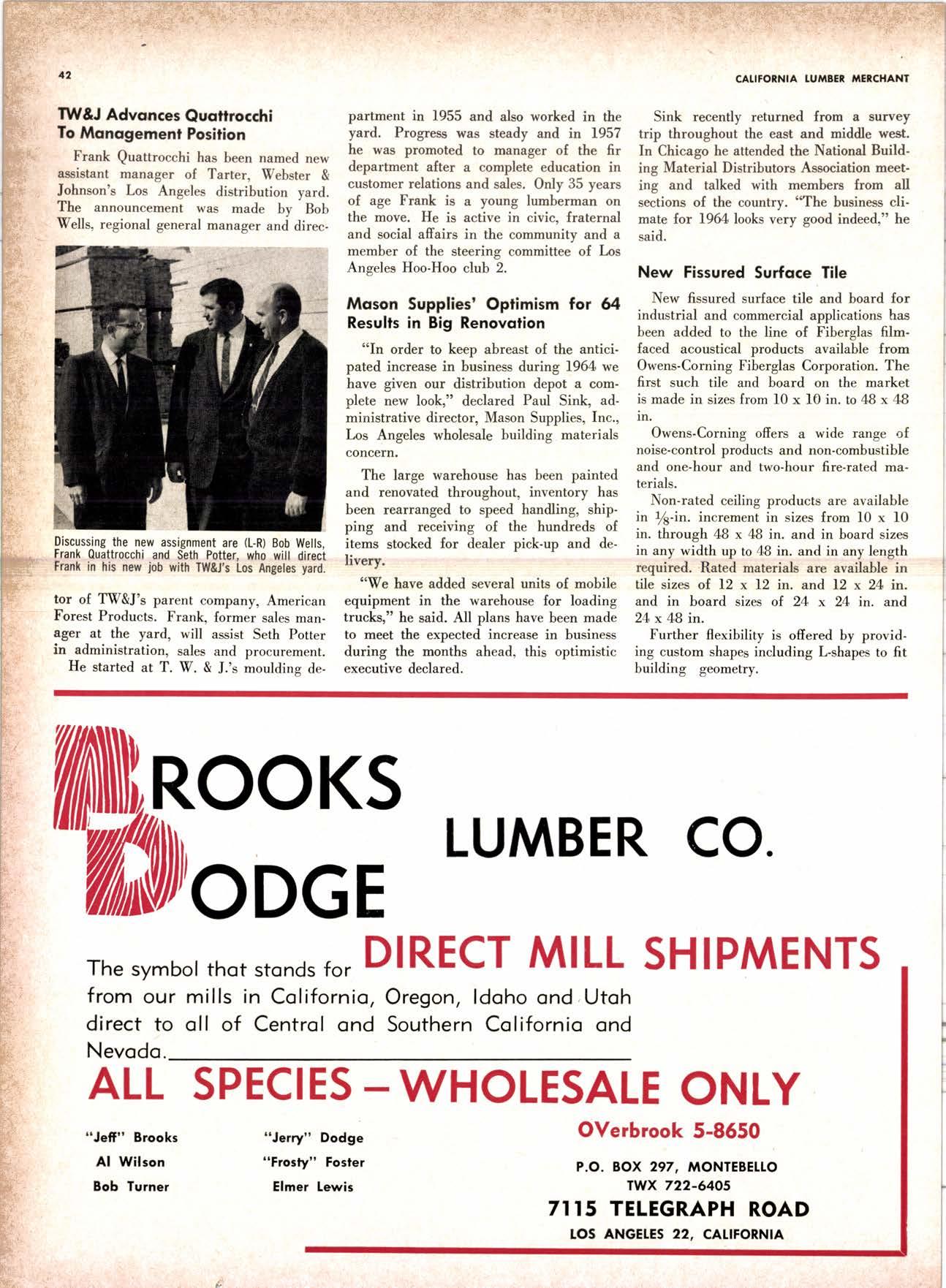
Moson Supplies' Optimism ior 64 Results in Big Renovqlion
"In order to keep abreast of the anticipated increase in business during 7964 we have given our distribution depot a complete new look," declared Paul Sink, administrative director, Mason Supplies, Inc., Los Angeles wholesale building materials concern.
The large warehouse has been painted and renovated throughout. inventory has been rearranged to speed handling, shipping and receiving of the hundreds of items stocked for dealer pick-up and delivery.
Catifornia Lumeer Menchant
Sink recently returned from a survey trip throughout the east and middle west. In Chicago he attended the National Building Material Distributors Association meeting and talked with members from all sections of the country. "The business climate {or 1964 looks very good indeed." he said.
New Fissured Surfqce Tile
New fissured sur{ace tile and board for industrial and commercial applications has been added to the line of Fiberglas filmfaced acoustical products available from Owens-Corning Fiberglas Corporation. The first such tile and board on the market is made in sizes from I0 x 10 in. to 48 x 48 in.
Owens-Corning offers a wide range o{ noise-control products and non-combustible and one-hour and two-hour fire-rated materials.
tor of TW&J's parent company, American Forest Products. Frank. {ormer sales manager at the yard, will assist Seth Potter in administration, sales and procurement.
He started at T. W. & J.'s mouldine de- lndustry Considers New Slrondord ture. Provision is also made for "qualifica- are planning major home improvement
"We have added several units of mobile equipment in the warehouse for loading trucks," he said. All plans have been made to meet the expected increase in business during the months ahead. this optimistic executive declared.
Non-rated ceiling products are ar.ailable in /6-in. increment in sizes from l0 x l0 in. through 48 x 48 in. and in board sizes in any width up to 48 in. and in any length required. Rated materials are available in tile sizes of 12 x 12 in. and 12 x 24 in. and in board sizes of 24, x 24 in. and 24 x 4,8 in.
Further flexibility is o{Iered by providing custom shapes including L-shapes to fit building geometry.
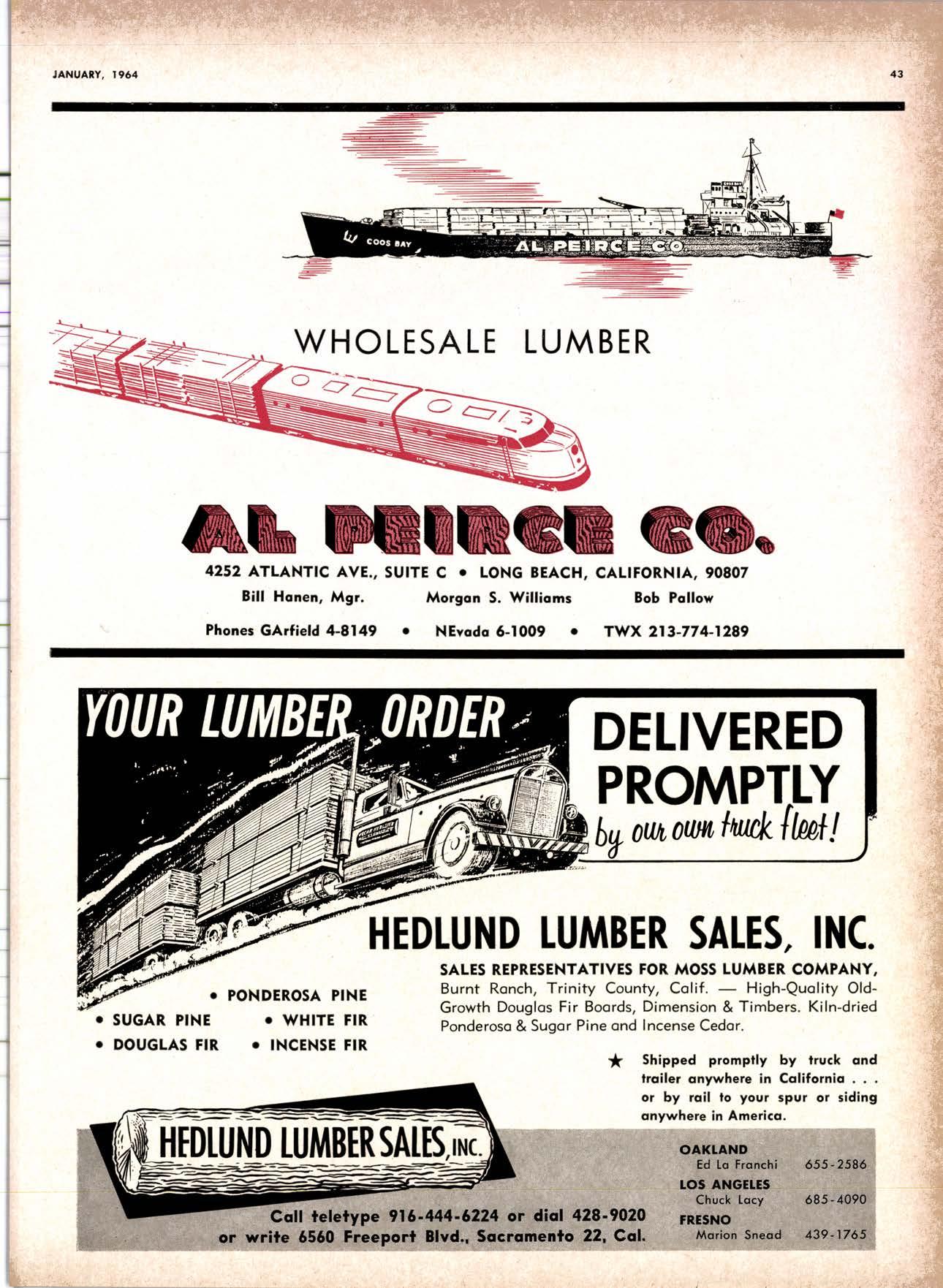
FOf MillwOrk TreOtment tion determination" by testing and inspec- projects because of the "tight new home servatives ls the objective of a "Co-.ut"i"l recorded -on "r, indiviilual company basis, families are b rjlgeting so that outside help commercial methods of utilizing wood pre- AIter general industry endorsement is ness will continue to grow' but that many for consideration, according to the Ofrce Department of Commerce. It is temporarily o'In addition, commercial remodeling of Commodity $tandardg National Bureau designated, TS-5579A, and is entided continues to present a relatively untapped of Standards. "Recommended Commercial Standard for market. Almost every community is rejuve-
The efiectivo treahent of millwork by tion bureaus. market." He added that handyman busi.
Sqndard recer*ly presented to the industry the standard will be issued by th; U. S: can complete the entire project.
The standard was proposed by the Na- Water-Repellent Preservative Non-Pressure r:ating its downtown area, and the aggres- tional Woodwork Manuiacturers Associa- Treatment for Millwork." Copies are avail- sive dealer with a sound sales progr:rm can tion and was developed with the coopera- able without charge from the Office of build dollar and profit volume by winning tion of other industry groups and the lo1rydiry Standards, NBS, Washington, these contracts," Marsh said.
Forest Products Laborato-ry, Department D'C. 20234.
He has found that the consumer is con- of Agriculture. It is now being circulated cerned about durability and easy mainfor industrv approval under a Commerce tenance. as well as cost. Marlite dealers for giving recognition
Remodeling to standards that are generally acceptable NgW Heights in 1964 to the trade.
Morket Moy Reqch have noted this trend now for several years.
"Today's homeowner or businessman is willing to spend the extra dollar for qual- cy and toiicity of the preservative solution and commer?l-should reach new v.ol' uid" y"u.. of service. Dealerg'therefore, treating such millwork items -as wood win-t, "u; n; Y,"l*: executive vice president start out with low price products that will . dows, "."r""rrr, blinds, shutters and doors of Marsh.Wall Products, manufacturer of not withstand hard wear. r are specified, as well as the test methods plastic'finished Marlite paneling' 'oHigh quality products with good profit for ditermining conformance and the depth . "Dealers who concentrate on building -argiis," Marsh stated, oobenefi"t botil the of solution penetration. The treatment is their rnodernization business, develop a dealer and custome.. ih" best products F intended to provide resistance against swell- thorough knowledge of brand name prod' often actually cost less to install, and the ' itrg, shrinkage, and warpage duJ to change. tltll and merchandise_effectively will make additional product cost can be a small item t' in moisture conditions, and to reduce attack 1964 a good year," Marsh stated. compared *ittt tt" total cost of a job, while ' by decay and stain organism whieh may The building materials executive pointed insuring customer satisfaction and giving occur when wood contains excessive mois- out that more homeowners than ever before the dealer a good profit."
Th; r"q"ir"-""rr for the water-repellen- Remodeling. businessboth residential ity priducts' if he knows that they will pro.

MIRROR TXX)RS
Northwesiern Distributors
TI|lRTHERI{ CALIFORNIA Cobbledick-Kibbe Glass Co. San Francisco, Oakland, Sacramento, Salinas, San Jose wAsH|l{GI0ll Belknap Glass Co., Seattle Empire Glass Co., Spokane Inland Glass Co.. Pasco Tacoma Glass Co., Tacoma Exchange Lumber Mfg. Co., Spokane
OREGON Fitzgibbon Glass Co., Portland Willamette Glass Co., Eugene
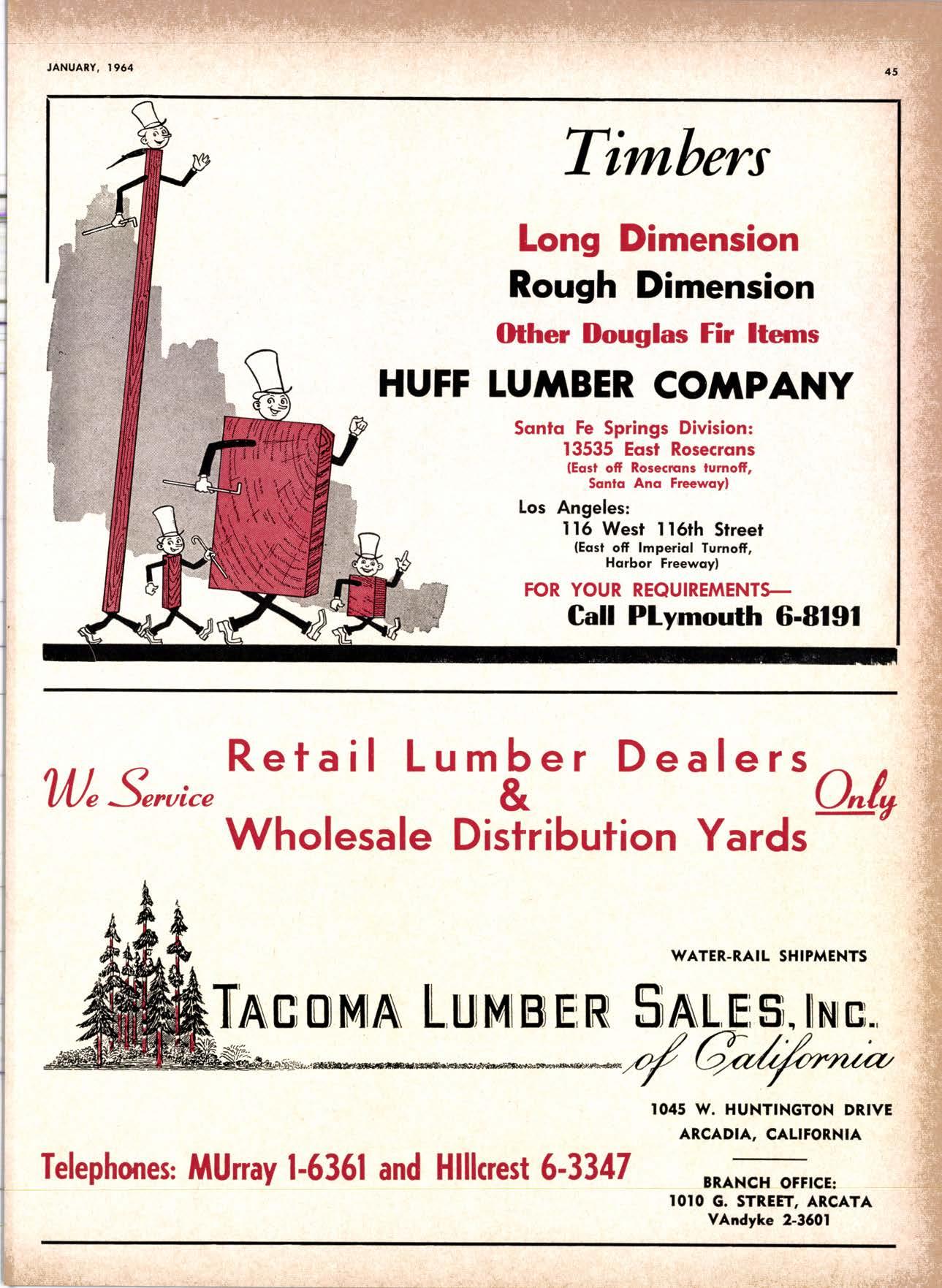
Growth Trends Show Five Areos To Get Bulk of Housing Stq*s
A leading construction economist has predicted that two-thirds of all housing starts in the 1960's will be concentrated in five geographical areas comprising less than l0 percent of the land area of the United States.
Dr. George Cline Smith, MacKay-Shields Economics, Inc., New York, said these five areas will feel the impact of "nearly all the population growth in the current decade," largely because of a nationwide "migration in the direction of water or warmer climates, or both."
The impact on the building materials industries will be profound, Smith said. The five areas of "population explosion" are expected to account for nearly 60 percent of the new housing market for lumber, two-thirds of the plywood market in housing, and more than three-fourths of housing demand for building board, he stated.
The central Great Lakes region, 3,000,000 units; the coastal area from Boston to Washington, which Smith referred to as a "Megalopolis," 2,950,000; o'metropolitan California" (principally, the section from San Francisco south to Los Angeles), 2,830,000; "metropolitan Texas," 1,020,(X)O; and Florida, 990,000.
Smith noted that the 1960's are expected to yield in the neighborhood of 16.2 million housing starts----or an average of slightly more than 1.6 million annually-with these five areas accounting for nearly lO.B million of the total.
The construction forecaster said that outside of these five areas, only a handful of metropolitan sections-Atlanta, Phoenix, Denver, Minneapolis and Seattle-are likely to register outstariding population gains in the l960's.
Nationally, Smith said the prospect is for a population increase of 47 million persons between now and 1975. He compared thi-" to adding to the U.S. the present population of France or Italy or "two and a-half Canadas."
Housing starts in 1964,he forecasts, will about equal this year's but a slight dip is expected in 1965-because of an "assumed-mild 1'grssssien"-4nd then a steady rise is likely until a 'osustainable" level of 2.2 million units annually is reached by 1975.
Smith suggested that lumbermen and other building materials manufacturers consider the population trend toward 'water and warmer climates" when developing merchandising and promotion programs for their dealers.
The building economist predicted total new housing demand for 116 billion board feet of lumber during the 1960-70 period. with about 60 per cent accounted for by the five areas of greatest population growth.
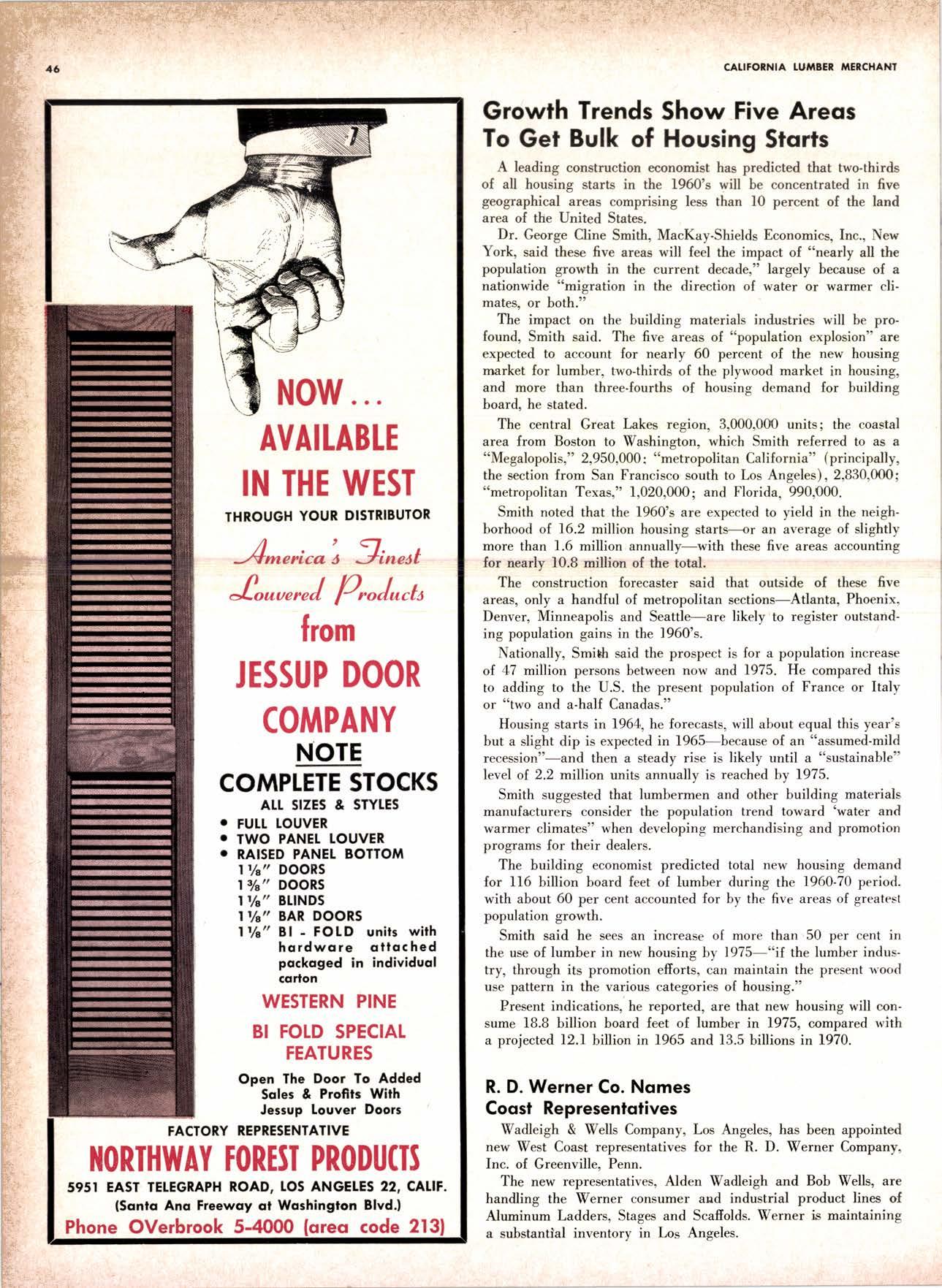
Smith said he sees an increase of more than 50 per cent in the use of lumber in new housing by 1975-"if the lumber industry, through its promotion efforts, can maintain the present wood use pattern in the various categories of housing."
Fresent indications, he reported, are that new housing will consume 1B.B billion board feet of lumber in 1975, compared with a projected 12.1 billion in 1965 and 13.5 billions in 1970.
R. D. Werner Co. Nqmes Coqst Representotives
Wadleigh & Wells Company, Los Angeles, has been appointed new West Coast representatives for the R. D. Werner Company, Inc. of Greenville, Penn.
The new representatives, Alden Wadleigh and Bob Wells, are handling the Werner consumer and industrial product lines of Aluminum Ladders, Stages and Scafiolds. Werner is maintaining a substantlal inventory in Los Angeles.
Number of Obsolete Trucks In Lumber Industry ls Up
The number of obsolete and over-age trucks used by lumber companies has increased sharply in the past two decades.
As a result, the economies inherent in private fleet operations are being wasted on excessive operating costs.
A nationaf survey has disclosed that the average age of lumber industry trucks was 7.3 years in 1962. In 1941 the average age of trucks used in the industry was 5.2 years. The survey was conducted by Wheels, Inc., Chicago, major automotive leasing fi rm. The study Covered. 2,347 companies operating 47,841 trucks. The national average age for all commercial and industrial trucks was 6.8 years in 1962, compared with 4.8 years in 1941.
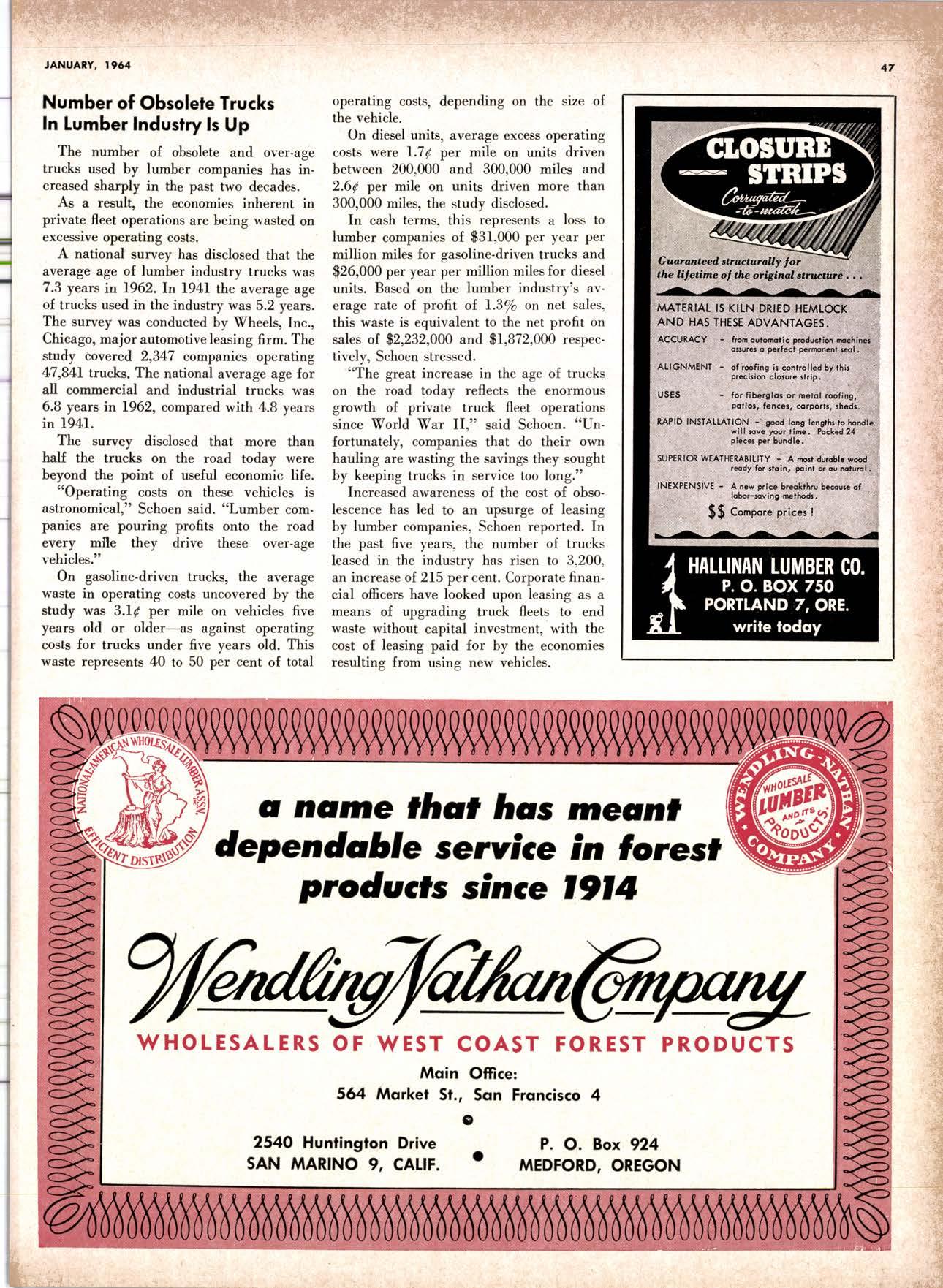
The survey disclosed that more than half the trucks on the road today were beyond the point of useful economic life.
"Operating costs on these vehicles is astronomical," Schoen said. "Lumber companies are pouring profits onto the road every mlle th"y drive these over-age vehicles."
On gasoline-driven trucks, the average waste in operating costs uncovered by the study was 3.ll per mile on vehicles five years old or older-as against operating costs for trucks under five years old. This waste represents 40 to 50 per cent of total operating costs, depending on the size of the vehicle.
On diesel units, average excess operating costs were l.7l per mile on units driven between 200,000 and 300,000 miles and 2.6( per mile on units driven more than 300,000 miles, the study disclosed.
In cash terms, this represents a loss to lumber companies of $31,000 per year per million miles for gasoline-driven trucks and $26,000 per year per million miles for diesel units. Based on the lumber industry's average rate of profit of. T.3/o on net sales, this waste is equivalent to the net profit on sales of $2,232,0W and $1,872,000 respectively, Schoen stressed.
"The great increase in the age of trucks on the road today reflects the enormous growth of private truck fleet operations since World \Var II," said Schoen. "Unfortunately, companies that do their own hauling are wasting the savings they sought by keeping trucks in service too long."
Increased awareness of the cost of obsolescence has led to an upsurge of leasing by lumber companieso Schoen reported. In the past five years, the number of trucks leased in the industry has risen to 3,20O an increase of 215 per cent. Corporate financial ofrcers have looked upon leasing as a means of upgrading truck fleets to end waste without capital investment, with the cost of leasing paid for by the economies resulting from using new vehicles.


